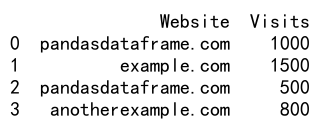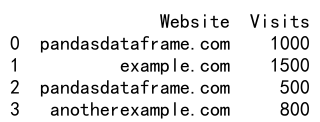Pandas Append DataFrame to Another
In this article, we will explore how to append one DataFrame to another using the pandas library in Python. Appending DataFrames is a common operation in data manipulation and analysis, allowing you to combine data from different sources or to incrementally add data to an existing dataset. We will cover various scenarios and methods to append DataFrames, including the use of the append() function, the concat() function, and handling issues like non-aligned indexes and columns.
Introduction to DataFrame Appending
Appending a DataFrame involves adding the rows of one DataFrame to another, potentially increasing the number of rows while keeping the number of columns fixed. This operation is crucial in scenarios where data is collected in a fragmented manner or when results from different sources or time periods need to be analyzed collectively.
Basic Append Operation
Let’s start with a basic example of appending two DataFrames. We will create two simple DataFrames and use the append() method to combine them.
Example 1: Basic Append
import pandas as pd
# Create two DataFrames
df1 = pd.DataFrame({
'Website': ['pandasdataframe.com', 'example.com'],
'Visits': [1000, 1500]
})
df2 = pd.DataFrame({
'Website': ['anotherexample.com', 'pandasdataframe.com'],
'Visits': [500, 800]
})
# Append df2 to df1
result = df1._append(df2, ignore_index=True)
print(result)
Output:

Handling Indexes
When appending DataFrames, managing the index is crucial to avoid duplicate indexes, which can lead to data misalignment. The ignore_index parameter can be used to reassign a new index to the resulting DataFrame.
Example 2: Append with Ignore Index
import pandas as pd
# Create two DataFrames with specific indexes
df1 = pd.DataFrame({
'Website': ['pandasdataframe.com', 'example.com'],
'Visits': [1000, 1500]
}, index=[1, 2])
df2 = pd.DataFrame({
'Website': ['anotherexample.com', 'pandasdataframe.com'],
'Visits': [500, 800]
}, index=[3, 4])
# Append df2 to df1 with a new index
result = df1._append(df2, ignore_index=True)
print(result)
Output:

Appending with Different Columns
When the DataFrames have different sets of columns, pandas will align columns by name and introduce NaN values for missing data in any column not present in one of the DataFrames.
Example 3: Append DataFrames with Different Columns
import pandas as pd
# Create two DataFrames with different columns
df1 = pd.DataFrame({
'Website': ['pandasdataframe.com', 'example.com'],
'Visits': [1000, 1500]
})
df2 = pd.DataFrame({
'Website': ['pandasdataframe.com', 'anotherexample.com'],
'PageViews': [3000, 1800]
})
# Append df2 to df1
result = df1._append(df2, ignore_index=True, sort=False)
print(result)
Output:

Using Concat for More Control
While append() is convenient, concat() provides more flexibility, especially when dealing with multiple DataFrames or needing specific configurations for concatenation.
Example 4: Using Concat Instead of Append
import pandas as pd
# Create two DataFrames
df1 = pd.DataFrame({
'Website': ['pandasdataframe.com', 'example.com'],
'Visits': [1000, 1500]
})
df2 = pd.DataFrame({
'Website': ['pandasdataframe.com', 'anotherexample.com'],
'Visits': [500, 800]
})
# Use concat instead of append
result = pd.concat([df1, df2], ignore_index=True)
print(result)
Output:

Handling DataFrames with Different Index Types
When appending DataFrames with different index types, such as a RangeIndex and a DateTimeIndex, it’s important to standardize or reset the index to avoid inconsistencies.
Example 5: Appending with Different Index Types
import pandas as pd
# Create two DataFrames with different index types
df1 = pd.DataFrame({
'Website': ['pandasdataframe.com', 'example.com'],
'Visits': [1000, 1500]
})
df2 = pd.DataFrame({
'Website': ['pandasdataframe.com', 'anotherexample.com'],
'Visits': [500, 800]
}, index=pd.date_range('20230101', periods=2))
# Reset index on df2 and append
df2.reset_index(drop=True, inplace=True)
result = df1._append(df2, ignore_index=True)
print(result)
Output:

Advanced Scenarios
In more complex scenarios, such as appending multiple DataFrames in a loop or handling large datasets, efficiency and memory management become crucial. Using concat() in a loop with a list accumulation pattern is often more efficient than repeatedly using append().
Example 6: Efficiently Appending Multiple DataFrames
import pandas as pd
# List to hold DataFrames
dfs = []
# Simulate creating multiple DataFrames
for i in range(5):
df = pd.DataFrame({
'Website': ['pandasdataframe.com', 'example.com'],
'Visits': [i * 100, i * 150]
})
dfs.append(df)
# Concatenate all DataFrames at once
result = pd.concat(dfs, ignore_index=True)
print(result)
Output:

Pandas Append DataFrame to Another Conclusion
Appending DataFrames is a fundamental aspect of data manipulation in pandas, enabling the combination of data from different sources or time periods into a single DataFrame. Whether you use the append() method for its simplicity or concat() for its flexibility, understanding how to effectively combine DataFrames is essential for efficient data analysis.
This article has provided a comprehensive guide to appending DataFrames in pandas, including handling different scenarios and considerations for efficient data processing. By following the examples provided, you should be well-equipped to handle most DataFrame appending tasks in your data analysis projects.
 Pandas Dataframe
Pandas Dataframe